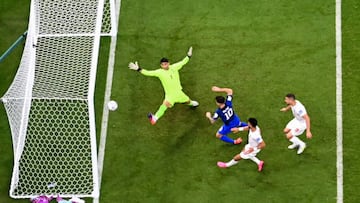In soccer, how much of the ball has to go over the line for it to be a goal?
With much of the decision-making now being automated, referees’ decisions are more accurate than ever. But at what point is a goal scored?

VAR gets plenty of negative coverage in the game today but one technology that has been far more universally accepted in soccer is goalline technology – even if not everyone sees its value. But where tech used or not, there’s a pretty big decision involved when the ball and the line come together.
While the hawkeye-powered intricacies of offside calls may leave fans scratching their heads, there is one area where the technology has cleared up a grey area: goal scoring.
Gone are the days when a referee’s position or point of view would determine whether a goal was allowed or not, particularly when that decision was intractable.
Goal-Line technology has been in use for the better part of a decade and much of the early criticism has given way to acceptance, and even a grudging admission that it is an improvement on the previous system.
All of the ball over all of the line
For a goal to be awarded in soccer, all of the ball must pass all of the goal line. If any part of the ball is still on a plane with the goal line when it is saved, there is no goal awarded.
Related stories
This often rubs casual American fans the wrong way. In football, for example, any of the ball breaking the plane of the goal is a score. Likewise in baseball, the ball must only catch the edge of the strike zone to be a strike. In soccer, however, close is not good enough. To score, the ball must be entirely inside the goal.
23. No goal for England in 2010 last 16
— Tom (@ScoresofHistory) November 27, 2022
Fans were left outraged when Frank Lampard seemed to erase a 2-0 deficit vs Germany after his shot crossed the goal line but was not counted. This moment intensified calls for the use of goal-line technology which is now standard today pic.twitter.com/1KAeSchPX4
One thing that caught soccer fans out in the early days of goal-line technology was the fact that the goal is measured at the line on the ground, which doesn’t necessarily square up with the posts and crossbar. Due to excessive tension on the net, it is not uncommon to see a backward bend to goalposts, sometimes giving the impression that a ball may not be fully in the goal when in fact it is.


Complete your personal details to comment